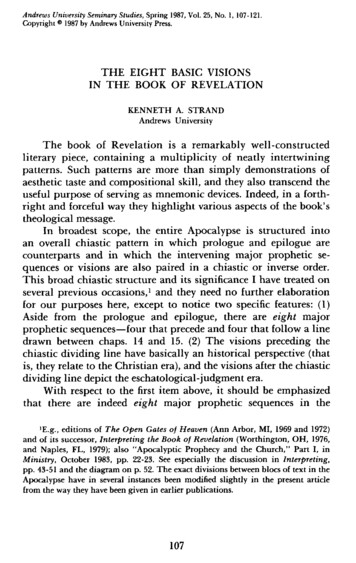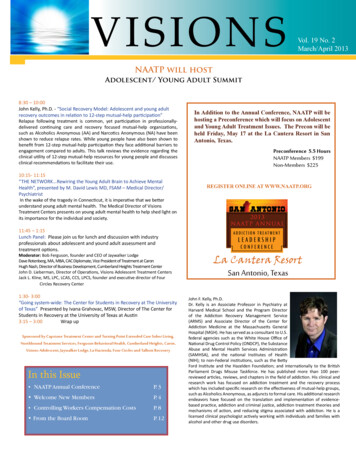
Transcription
Andrews University Seminary Studies, Spring 1987, Vol. 25, No. 1, 107-121.Copyright Q 1987 by Andrews University Press.THE EIGHT BASIC VISIONSIN THE BOOK OF REVELATIONKENNETH A. STRANDAndrews UniversityThe book of Revelation is a remarkably well-constructedliterary piece, containing a mu1tiplici ty of neatly intertwiningpatterns. Such patterns are more than simply demonstrations ofaesthetic taste and compositional skill, and they also transcend theuseful purpose of serving as mnemonic devices. Indeed, in a forthright and forceful way they highlight various aspects of the book'stheological message.In broadest scope, the entire Apocalypse is structured intoan overall chiastic pattern in which prologue and epilogue arecounterparts and in which the intervening major prophetic sequences or visions are also paired in a chiastic or inverse order.This broad chiastic structure and its significance I have treated onseveral previous occasions,l and they need no further elaborationfor our purposes here, except to notice two specific features: (1)Aside from the prologue and epilogue, there are eight majorprophetic sequences-four that precede and four that follow a linedrawn between chaps. 14 and 15. (2) The visions preceding thechiastic dividing line have basically an historical perspective (thatis, they relate to the Christian era), and the visions after the chiasticdividing line depict the eschatological-judgment era.With respect to the first item above, it should be emphasizedthat there are indeed eight major prophetic sequences in thelE.g., editions of The Ofien Gates of Heaven (Ann Arbor, M I , 1969 and 1972)and of its successor, Interfireting the Book of Revelation (Worthington, O H , 1976,and Naples, FL, 1979); also "Apocalyptic Prophecy and the Church," Part I, inMinistry, October 1983, pp. 22-23. See especially the discussion in Interpreting,pp. 43-51 and the diagram on p. 52. The exact divisions between blocs of text in theApocalypse have in several instances been modified slightly in the present articlefrom the way they have been given in earlier publications.
IIPROLOGUE8:2-11:18TrumpetWarnings(7 Trumpet.)11819-14r20Evil PowersOpposingCod and HisSaintrVII16:18-18:24-rEvil Powere 19:l-2134JudgedCod ' 8by CodJudgment(The "7 LaoFinalePlagues")Christ's 2dAdvent, theMillennium,the 22:s"Church("New Heavenand NewEarth";Holy City,JerusalemDIAGRAM 1. THE CHIASTIC STRUCTURE OF THE BOOK OF REVELATION
BASIC VISIONS I N THE BOOK OF REVELATION109Apocalypse, not seven, as various interpreters have assumed.* Concerning the second item, several qualifications should be noted: Inthe second through fourth visions, each historical sequence concludes with a section that portrays the time of eschatologicaljudgment; and in the subsequent visions, which in their essencefurnish an enlargement on that eschatological-judgment era, thereare two kinds of material that pertain to the historical eraexplanations (which must obviously be made in terms of theprophet's own perspective in history); and exhortations or appeals(which have value only prior to the eschatological judgment andwhich would, of course, be meaningless at the time of the finaleschatological judgment itself ). These qualifications concerning"exceptions" to the main thrust or coverage of the visions on eachside of the chiastic dividing line should not, however, be considered as "crossover'' materials. These data are important parts oftheir own sequences, are in proper position as they stand, andspeak significantly to the contexts in which they are found. Moreover, they are discrete and meaningful units as to nature, placement, and/or purpose, within their own specific visions.For convenience, the comprehensive chiastic structure of Revelation into prologue, epilogue, and eight visions is set forth inoutline form in Diagram 1, which includes also my suggestions asto the textual boundaries and general topics of the various visions.In this diagram and throughout the remainder of the discussion inthis article, the term "visions" will refer to these eight completeprophetic sequences, not to individual visionary experiences oflesser extent. Also, Roman numerals will be used to identify thevisions in sequence.The present study has two main purposes, and the data pertaining to each of these will be presented in separate articles: First,the present essay analyzes. briefly some parallel patterns in the?Such interpreters have apparently drawn the conclusion that because seven is asignificant number symbol in Revelation-occurring, for instance, in four explicitseptets: the churches, seals, trumpets, and bowls-there is also supposed to be a totalof seven basic visions. For examples of the seven-vision approach, see ErnstLohmeyer, Die Offenbarung des Johannes (Tiibingen, 1926); John Wick Bowman,The Drama of the Book of Reuelation (Philadelphia, 1955) and "Revelation" in ZDB4:64-65; and Thomas S. Kepler, The Book of Revelation (New York, 1957). Lohmeyer and Bowman find septets, as well, within all of their seven major visions,though they lack agreement even as to these seven visions themselves. Kepler, on theother hand, finds only a total of ten subsections (called "scenes") within his sevenmajor visions (major visions whose textual boundaries vary only slightly from theseven major visions outlined by Bowman).
DIAGRAM 2.PARALLELING STRUCTURES IN REVELATION'S EIGHT MAJOR VISIONSVII-VICTORIOUSVICTORIOUSINTRODUCTION TION TION HATOLOGICALCULMINATION:SCHATOLOGICAL LUDEINTERLUDE:SCHATOLOCICAL ESCIUTOLOCICAL CPROPHETICDESCRIPTION
BASIC VISIONS I N THE BOOK OF REVELATION111eight major visions of the book of Revelation. Then a follow-uparticle3 will focus a bit more intensively on the particular blocs oftext that introduce these eight visions and which can be designatedas "victorious-introduction scenes," inasmuch as they provide foreach vision a setting which portrays in dramatic fashion God'spresent care for his people and gives assurance of ultimate victoryfor Christ's saints or "loyal ones." For purposes of identification inthe present article, Roman numerals (I, 11, etc.) will continue to beused, as in Diagram 1, for designating the eight visions. Eachvision, however, has either two or four main sections or blocs oftext, and capital letters (A, B, etc.) will serve as identifiers for these.1. An Analysis of Pa.tterns Within the Eight VisionsThe first and the final visions (I and VIII) of the Apocalypseare composed of a "Victorious-Introduction Scene'' (A), plus onefurther main bloc of text (B) that may be called the "Basic PropheticDescription." The other six visions (11-VII) have these same twoblocs, but with the addition of two further blocs (C and D).In this essay, the third blocs of text in the second through seventh visions are throughout given the basic caption of "Interlude"a term quite regularly applied by the exegetes for these particularsections in visions 11, 111, and IV, but equally applicable to thecorresponding (but much shorter) sections in visions V, VI, andVII. It should be noted, however, that although the term "interlude" frequently suggests an interruption to, or hiatus within, theflow of thought, what these third blocs of material do in visions11-VII of the Apocalypse is to enhance or intensify the thrust of theimmediately preceding material.* The fourth bloc can be designated as the "Eschatological Culmination"; and in a certain sense,both it and the preceding "Interlude" are actually an extension ofthe "Basic Prophetic Description" begun in the second bloc.Although it will be necessary later in this article to add certainfurther refinements to the foregoing basic analysis, at this point wemay summarize in diagram form the results reached thus far. Sucha summary is provided in Diagram 2.3This will hopefully be presented in the next issue of AUSS, or at least withinthe present annual volume."Paul S. Minear has spoken poignantly to this matter in connection with the"interlude" which occurs at 16:15. See below, n. 9 and the quoted material to whichthat note refers.
KENNETH A. STRAND2. Summary of Contents of the VisionsAt this juncture it is useful to take an overview of the contentof each of the eight visions. The summaries given here follow thebroad lines of structure indicated above. It should be emphasizedthat these are indeed summaries, and the reader can fill in details byconsulting the texts indicated for each of the visions.THE HISTORICAL VISIONSVision I, 1:lOb-3:22Bloc A, Victorious-Introduction Scene, 1:IOb-20. Christ appears toJohn on Patmos as the ever-living and all-powerful One, whowalks among the seven golden candlesticks that represent the sevenchurches.Bloc B, Basic Prophetic Description, Chaps. 2 and 3. Christ givesmessages of praise, rebuke, warning, and exhortation to the individual churches as their varying conditions require.Vision 11, 4:1-8:lBloc A, Victorious-Introduction Scene, Chaps. 4 and 5. John sees athrone set in heaven, with a sea of glass and seven lamps of firebefore the throne, and with four living creatures and twenty-fourelders surrounding the throne. In a dramatic and suspenseful scenethe declaration is made that the slain Lamb alone is able to takefrom the hand of the one seated on the throne a seven-sealed scrolland to break the seals and open the scroll. The Lamb then takes thescroll, and anthems of praise ascend from the four living creatures,the twenty-four elders, and the entire universe.Bloc B, B& Prqhetic Description, Chap. 6. The first six seals of thescroll are broken, with the result that four horsemen go forth, soulsunder the altar utter a cry of "How long" until there is judgmentand vindication for them, and signs are given on earth and inheaven of impending judgment.Bloc C, Interlude, Chap. 7. The sequence is "interrupted" to focus onthe sealing of 144,000 during the end-time.Bloc D, Eschatological Culmination, 8:l. The seventh seal is opened,at which there is "silence in heaven" for the duration of half anhour.
BASIC VISIONS I N THE BOOK O F REVELATIONVision 111, 8:2-11:18Bloc A, Victorious-Introduction Scene, 8:2-6. Seven angels with trumpets appear, and another angel goes to the golden altar and thereoffers incense whose smoke, mingled with the prayers of the saints,ascends to God. Next, the angel fills a censer with live coals fromthe altar and throws this upon the earth, resulting in the judgmentsymbols of voices, thunder, lightning, and earthquake.Bloc B, Basic Prophetic Description, 8:7-9:21. The first six trumpetsare blown, feleasing forces of devastation that embrace the symbolisms of a storm of hail upon the earth, a great burning mountainthrown into the sea, etc. The first five of these trumpets drawimagery from the plagues on ancient Egypt, but the sixth trumpetshifts the background to Babylon by mention of the "great riverEuphrates" in 9: 14.5Bloc C, Interlude, 10:I-11:13. An angel holding an open scroll announces (10:6) that "there should be time no longer" (KJV); or, asalternatively translated, "there should be no more delay" (RSV).6John is commanded to eat the scroll and does so, finding it sweet inhis mouth but bitter in his stomach; the prophet is then instructedto measure the temple, altar, and people (a direct allusion, as I haveshown elsewhere, to the year-end "Day -of -Atonementu ritual in theancient Jewish cultus'); and the testimony and career of the twowitnesses are described.5The phenomenon encountered here may be termed the "Exodus-from-Egypt"/"Fall-of-Babylon" motif. It occurs twice, in each instance embracing two completevisions. The first occurrence is Rev 8:Z- l4:ZO inclusive, and the second is Rev 15:l18:24 inclusive. For further detail and a diagram, see K. A. Strand, "The TwoWitnesses of Rev 11:3-12," AUSS 19 (1981): 128-129.6The difference in rendition is not really as significant as might at first appear.The passage is an obvious allusion to the book of Daniel that was to remain sealeduntil "the time of the end" (Dan 12:4; cf. Rev 10:2) and to the query by Daniel,"Until when . . . ?" (Dan 12%).Either translation of this particular statement in Rev10% fits well as a response to the question raised by Daniel, and indeed is anemphatic proclamation of the arrival of the end of the time period projected-"atime, two times, and half a time" (Dan 12:7).The Greek of this last clause of Rev 10:6reads, hoti kronos ouketi estai. (Cf. the "until when" in Dan 8:13.)7K.A. Strand, "An Overlooked Old-Testament Background to Revelation 11:1,"AUSS 22 (1984):317-325.
114KENNETH A. STRANDBloc D, Eschatological Culmination, 11:14-18. The seventh trumpetis blown, resulting in the announcement that "the kingdom of theworld has become the kingdom of our Lord and of his C h r i t " ;then an anthem of praise arises, emphasizing, among other things,that the time has come for judgment of the dead, for rewarding thesaints, and for destroying the "destroyers of the earth."Vision IV, ll:l9-l4:2OBloc A, Victorious-Introduction Scene, 11:19. "God's temple in heavenwas opened," making visible "the ark of his covenant"; then "flashesof lightning, voices, peals of thunder, an earthquake, and heavyhail" occur.Bloc B, Basic Prophetic Description, Chaps. 12 and 13. The dragon,leopard-like sea beast, and two-horned earth beast persecute God'speople.Bloc C, Interlude, 14:l-13. John sees (1) the Lamb and the 144,000victorious saints standing on Mt. Zion, and (2) three angels flying inheaven and proclaiming warning messages.Bloc D, Eschatological Culminatwn, 14:14-20. Earth's twofold harvestis reaped-(1) the harvest of grain, and (2) the grapes that arethrown into the great winepress of God's wrath.THE ESCHATOLOGICAL-JUDGMENTVISIONSVision V, 15:l-16:17Bloc A, Victorious-Introduction Scene, l5:l-l6:1. The victorious saintsstand on the sea of glass and sing the Song of Moses and the Lamb;and when the "temple of the tent of witness in heaven" is opened,seven angels come forth and receive seven bowls "full of the wrathof God," smoke fills the temple so that no one can enter till theplagues of the seven angels have been completed, and finally instruction is given to the angels to go their ways and pour out the bowls.Bloc B, Basic Prophetic D e s M t i o n , 16:2-14. The first six bowls ofwrath are poured out, with devastating effects on earth, sea, riversand fountains, etc. (Again, as in the trumpets septet, imagery for thefirst five bowls is patterned after the plagues on ancient Egypt, withthe scene shifting to Babylon as the sixth bowl refers to the "greatriver Euphrates" in 16:12.)8Hereinafter the RSV will be used for English renditions of the biblical text,with the possible exception of brief two- or three-word excerpts.
BASIC VISIONS IN THE BOOK O F REVELATION115Bloc C, Interlude, 16:15. Into the description of the sixth bowl-thedrying up of the Euphrates and the presence of demonic spirits thatdeceive the kings of the earth and lead them to the "battle of thegreat day of God the Almighty" (16:12-14)-is inserted a strikingmacarism in vs. 15: "Lo, I [Christ] am coming like a thief. Blessed ishe who is awake. . . . " Then follows an added comment to theeffect that the place of the battle is called "Armageddon" (vs. 16).Since we have now moved into the section of the Apocalypse thatprovides visions of the eschatological judgment, rather than pertaining to the historical era, it is obvious that a new sort of "interlude" can be expected, as is indeed the case here. The earlierinterludes were somewhat detailed descrifitions of events or conditions during a final portion of the historical era. The interludes thatoccur in visions V-VII are rather of a crisp, hortatory nature.The question may be asked, Why such interludes here? For thisparticular one in Rev 16:15, Paul S. Minear has aptly pointed out:"The saying reveals the terrible danger in which the unsuspectingChristian stands. If one asks with R. H. Charles, 'How could anyone sleep through the cosmic earthquakes which were happening?,'one may answer, 'That is just the point.' There were Christiansasleep, so John believed, quite undisturbed by din of doom, unawarethat anything was happening that could threaten their treasure orleave them exposed and naked. T o be asleep was to be unconsciousof the urgent necessity of the time. (Compare the disciples in Gethsemane, Mk. 1426-42.) The beatitude was designed for sentinelswho had forgotten that a war was being fought."gBloc D, Eschatological Culmination, 16:l7. The seventh bowl ofwrath is poured out, and there issues from the throne in the templein heaven the declaration, "It is done!"Vision VI, l6:18-18:2#Bloc A, Victorious-Introduction Scene, 16:18-l7:3a. The traditionalsigns of judgment occur (voices, thunder, lightning, earthquake,and hail), and "great Babylon" comes into "judgmental remembrance" before God. John is then taken into the wilderness to seethis judgment upon Babylon.Bloc B, Basic Prophetic Description, 17:3b-189. A description ofBabylon as a harlot and also of the seven-headed and ten-hornedscarlet-colored beast upon which she rides is introduced in the earlyverses of chap. 17 (vss. 3b-8). This descriptive scene is followed bygPaulS. Minear, ISaw a New Earth(Washington, DC, 1968),p. 150.
116KENNETH A. STRANDconsiderable explanatory detail (vss. 9-18) that culminates in areference to the devastation of the harlot by the beast's ten horns(vss. 16-17)and the identification of this harlot as the great city thatrules over earth's kings (vs. 18). In the first three verses of chap. 18, arecital of various aspects of Babylon's corruption sets the stage forthe interlude appeal and the description of destruction that follow.Bloc C, Interlude, 18:4-8, 20. Before the actual portrayal of Babylon'sdevastation through fire, an appeal is made for God's people to"come out" of Babylon, so that they do not become participants inher sins and recipients of her plagues. In this connection there isalso a reiteration, in elaborated form, of God's decree of judgmentagainst Babylon.Inasmuch as in the chiastic structure of the material in chap. 18,vs. 20 is a chiastic counterpart to vss. 4-8,lO both of these "interludes" within this particular chiasm should probably be consideredas the total "interlude" for the larger sequence from 17:3b-18324.Vs. 20 gives a call for rejoicing over the fact that God has proclaimed against Babylon herself the judgment which she had imposed upon God's people. l1Bloc D, Eschatological Culmination, 18:9-19, 21-24. The central section of chap. 18 (vss. 9-19) portrays, through a threefold dirge,Babylon's utter desolation by fire; and the final section of thechapter (vss. 21-24) emphasizes Babylon's doom and her utterlydesolate condition after God's judgment upon her.Vision VII, 19:l-21:4Bloc A, Victorious-Introduction Scene, 19:l-10. In a heavenly settingthat parallels the setting given in chap. 4, anthems arise in praise ofGod for his having judged the great harlot Babylon and vindicatedGod's people; then reference is made to the Lamb's bride beingready for the wedding, and a blessing is pronounced upon thosewho are "invited to the marriage supper of the Lamb." (It should be'Osee William H. Shea, "Chiasm by Theme and by Form in Revelation 18,"AUSS 20 (1982): 249-256; and Kenneth A. Strand, "Two Aspects of Babylon'sJudgment Portrayed in Revelation 18," AUSS 20 (1982): 53-60."See Strand, "Two Aspects of Babylon's Judgment," pp. 55-59; and for anupdated more-literal rendition of Rev 18:20b, see idem, "Some Modalities of Symbolic Usage in Revelation 18," AUSS 24 (1986): 43-45. In the background of bothRev 18:4-8 and vs. 20 is the law of malicious witness (cf. Deut 19:16-19;and also seeEsth 7:9-10).
BASIC VISIONS IN THE BOOK OF REVELATION117noted that though the heavenly temple setting of chaps. 4-5 andchap. 19 is the same, there is difference with respect to activity andperspective-a fact also made clear by the content of the anthems inthe two visions. The former vision pertains clearly to the historicalera, and this one pertains just as clearly to the era of eschatologicaljudgment.)Bloc B, Basic Prophetic Description, 19:ll-20:5.Christ's second adventis dramatically portrayed, and consequences of it are given. Amongthe negative results enumerated are the birds' feast consisting of theenemies of God (19:17-18), the lake-of-fire fate for the beast and falseprophet (19:19-20), and the imprisonment of Satan in the "bottomless pit" or "abyss'' for a thousand years (20:l-3). On the positiveside is the first resurrection, in which the martyred saints arise. Theythen live and reign with Christ for a thousand years (20:4-5).Bloc C, Interlude, 20:6. "Blessed and holy is he who shares in the firstresurrection! Over such the second death has no power. . . . "Bloc D, Eschatological Culmination, 20:7-21:4. The culminatingevents at the end of the thousand years are set forth. On the negativeside are the loosing of Satan, the resurgence of his deceptive work,the vain effort of his evil confederacy to capture "the camp of thesaints," and the final fiery destruction of this confederacy. On thepositive side is John's vision of "a new heaven and a new earth,"with the holy city New Jerusalem descending from heaven to earth,and God himself tabernacling with his people.Vision WZZ, 21:5-22:5Bloc A, Victorious-Introduction Scene, 21:5-lla. The proclamation ismade that Christ's victorious ones will inherit all things, and Johnsees the holy city New Jerusalem descend from heaven to earth. (Asa backdrop, the final section of the preceding vision has alreadyportrayed the condition on earth after the descent of the New Jerusalem [21:1-41.)Bloc B, Basic Prophetic Description, 21:llb-2235. The holy city NewJerusalem is described in detail.3. Further Analysis of Text-Blocs A, B, C, and DWith the foregoing background, we may now proceed to somefurther generalizations concerning the nature of the respective sections (A, B, etc.) within the eight visions. Also, we can suggestadditional notations for the captions to these blocs of text, beyond
118KENNETH A. STRANDwhat has already been indicated in the earlier sections of this articleand in Diagram 2.As we consider the "Victorious-Introduction Scene" for eachof the eight visions, we find that there is always a basic templesetting and/or temple-imagery background of some sort.l2 Therefore, our caption of "Victorious-Introduction Scene" (bloc A) cannow be supplemented with the phrase, "with Temple Setting."As for the second through fourth blocs of text (blocs B, C, andD), a difference in perspective should be noted between the visionspreceding the chiastic dividing line (visions I-IV) and the visionsfollowing it (visions V-VIII). With respect to the former, the "BasicProphetic Description" is within the historical arena; with respectto the latter, the basic vision material in the B blocs pertains to theeschatological or final judgment. For visions I-IV, therefore, the"Basic Prophetic Description" needs the added qualification "inHistory"; and for visions V-VIII that qualification would be "inFinal Judgment. "As for the third blocs of text (C), in visions 11-IV the basicdesignation of "Interlude" may likewise be supplemented with anadditional phrase-"Spotlight on Last Events" (meaning prior toChrist's second advent), inasmuch as the "Interlude" in each instance enlarges on the period of time just before the eschatologicalculmination. For visions V-VII the added phrase "Exhortation orAppeal" is appropriate, for the terrors of the final-j udgment scenesare "interrupted" in order to give short blocs of text setting forth121nsome cases the temple in heaven is mentioned explicitly, as in the introductory scenes to visions IV and V; and in other cases, the allusion to temple furnituregives evidence of a temple setting, even though the word "temple" does not occur,as in the scenes for visions I, 11, and 111. The only introductory scenes that do nothave so obvious a clue to temple imagery are those for visions VI and VIII. In thecase of the former, there is, however, in the preceding verse (16:17, the final bowlplague, but also a "swing element" to what follows) the mention of a voice "out ofthe temple, from the throne." With respect to vision VIII, there is reference to theone who "sat upon the throneu-identified earlier as God in his temple (cf., e.g.,4:Z- 11, 19:1-5); and moreover, the immediately preceding bloc of text (again a sort of"swing element") refers to God as "tabernacling" in the "new earthm/"New Jerusalem" with his people (213). Additionally it should be noted that the followingbloc of text, or "Basic Prophetic Description" for vision VIII, states that the templein the holy city New Jerusalem "is the Lord God the Almighty and the Lamb"(21:22). My second article in this series will elaborate on the nature and theologicalsignificance of the temple imagery that appears in the introductory scenes to theeight major visions of the Apocalypse.
BASIC VISIONS IN THE BOOK OF REVELATION119encouragement to faithfulness and/or appeals for repentance. (Intwo of these instances of exhortation or appeal, the interlude iscast, as we have already seen, basically in the form of a macarism16:15 and 20:4.)The sections on "Eschatological Culmination" (the D blocs)all pertain to the final eschatological consummation, as notedearlier; but those concluding sections for visions 11-IV provide aclimactic conclusion to series that relate to the historical era,whereas those for visions V-VII deal specifically with the final orterminating portion of eschatological-judgment series already inprogress in the earlier sections of those visions. Blocs D for visions11-IV may therefore be designated as "Eschatological Culmination:Climax to History," and the D blocs for visions V-VII may betermed "Eschatological Culmination: The Judgmental Finale."Diagram 3 (on the next page) incorporates the above-mentionedrefinements to the data given in Diagram 2, and also includes mysuggestions as to the textual boundaries for the blocs of material asset forth in the second section of the present article.4. ConclusionIn this article, we have observed that there is a very consistentand balanced literary structure in the book of Revelation. Thisstructure not only has aesthetic and mnemonic values or qualities,but also speaks significantly to the theological message of the book.Various aspects of the theology will be dealt with in a follow-uparticle that will explore in further detail the "victorious-introduction scenes" to the eight visions, but one significant theologicalfocus may be mentioned here: The broad chiastic structure itselfemphasizes a twofold theme that embraces and undergirds thevarious messages of the book-(1) that Christ is Alpha and Omega,and (2) that he will return at the end of the age to reward allpersons according to their works (Rev 1:7-8 and 22:12-13). In otherwords, he is a consistent, trustworthy, and ever-present help andsupport to his faithful ones during this historical era of adversityfor them (cf. Rev 1:17-18; Matt 28:20b; John 16:33; Heb 12:Za; 1323);and he will personally return to usher in the series of events thatdestroy the "destroyers of the earth" and that provide to his loyalfollowers the inheritance of the "new earth" and the fulfillment ofall the good promises made to them (see Rev 11:15-18; 21: 1-4, 7,
DIAGRAM 3. OVERVIEW OF STRUCTURE AND CONTENT OF THE APOCALYPSEIIHI!3TORICAL-ERA VISIONS1vIVICTORIOUSVICTORIOUSINTRODUCTION INTRODUCTIONSCENESCENEWInt TD(PLEV I M N INTRODUCTIONSCENESCENEulm TEHPLBWITH TMPLESETTINCSETTING(1: lob-20)(Chaps. b 6 ICDESCRIPTIONINHISTORY(8 VIIIVI IvIvVIClORIOUSVICTORIOUSINTRODUCTION INTRODUCTIONSCENESCENEWITH TMPLCWITH TEWLESrnINCSETTING(16:18-17: ).3(15: 1-16: ESCENEWITH TEXPLEWITH T W L ESETTINGSETTING(19:l-10)(21: 5-lla)BASICPROPHETICDESCRIPTIONINHISTORYChaps. 12 6 13:BASICPROPHETICDESCRIPTIONIN FINALJUDGMENT(16: 2-14.16)BASICPROPHETICDESCRIPTIONIN FINALJUDCXENTBASICPROPHETICDESCRIPTIONIN FINALJUD(;nENT(19: 11-20: 5)INTERLUDE:SPOTLIGHT ONLAST EVEIlTSINTERLUDE:EXHORTATIONOR APPFALINTERLUDE:eXHORTATIONOR APPEALINTERLUDE:EXHORTATIONOR APPEAL(18r4-8.20)(20:6)-iINTERLUDE:c E:;rmyINTERLUDE:SPOTLICHT ONLAST EVENTS- -.ESCHATOLOGICAL ESCHATOLOGICAL LIHAX ToCLI)W( TOC L W TOHISTORYHISTORYHISTORY---SCHATOLOGICAL ESCIiATOLOCICM E JUDQIENTAL HE J V D C H M U M E ONIN FINALJUDGMENT(21: 11b-22: 5)
BASIC VISIONS I N THE BOOK OF REVELATION12122-27; 22: 1-5).l3 The four prophetic sequences preceding the chiastic dividing line deal primarily with the first aspect, and the fourmajor visions subsequent to that dividing line are devoted mainlyto the second aspect.In closing, one further item may also be briefly introducedhere: It is noteworthy that in the introductory scenes of the eightvisions, the temple imagery reveals a pattern of first an earthlyvenue in vision I (candlesticks that represent churches on earth),followed by a heavenly venue in visions 11-VII (either [a] an explicitmention of the "temple in heaven" or its furniture and/or [b] abackground that indicates
The Drama of the Book of Reuelation (Philadelphia, 1955) and "Revelation" in ZDB 4:64-65; and Thomas S. Kepler, The Book of Revelation (New York, 1957). Loh- meyer and Bowman find septets, as well, within all of their seven major visions, though they lack agreement even as to these seven visions themselves. Kepler, on the










